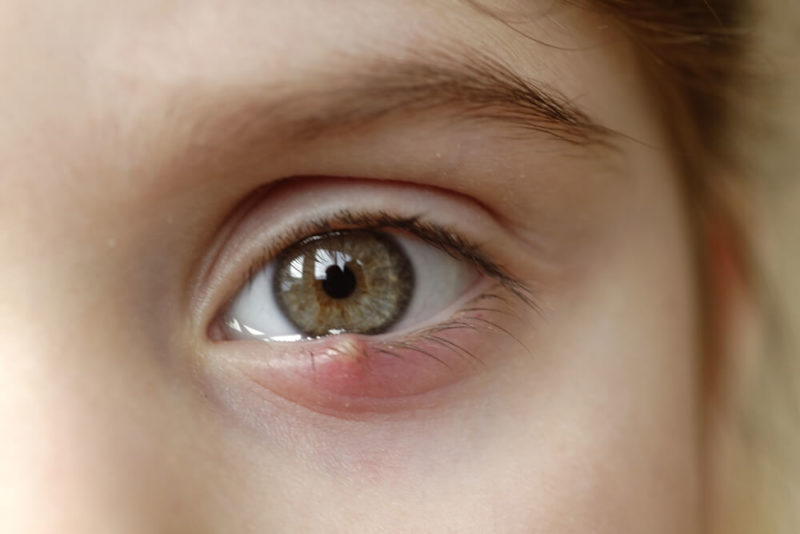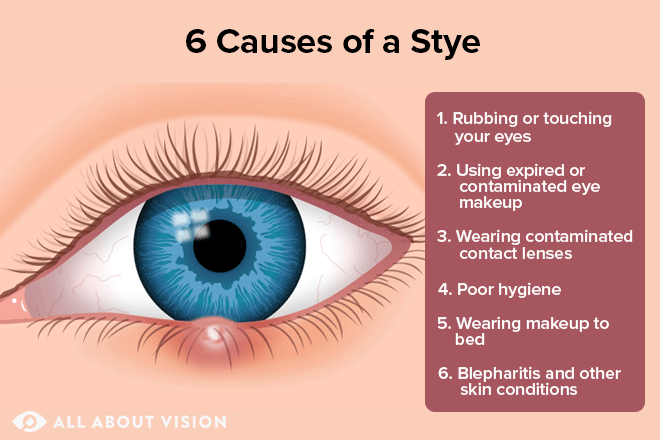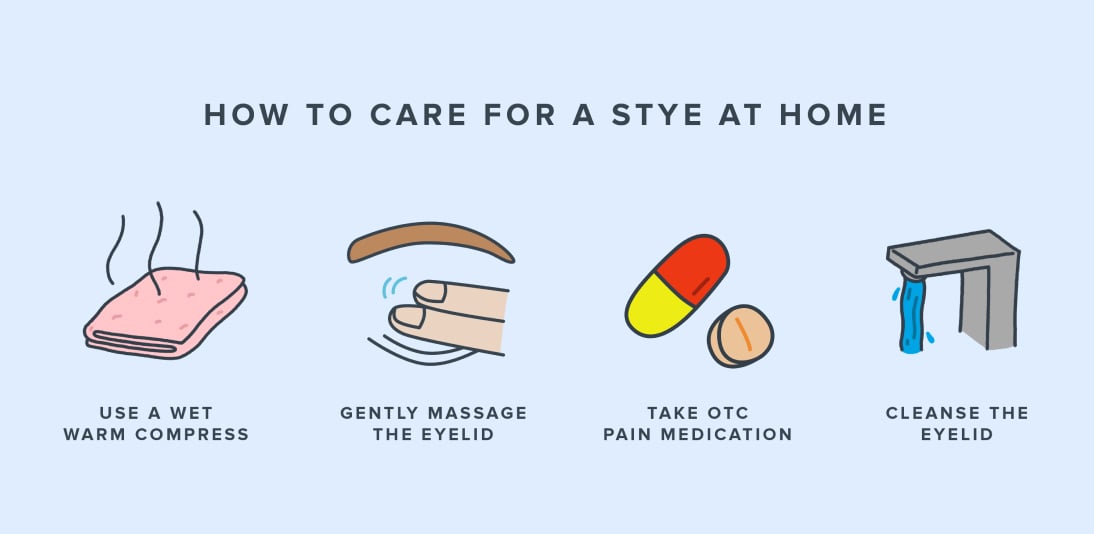
A stye is an inflammation of the eyelid that is usually caused by an infection caused by bacteria, usually staphylococci. This inflammation is usually located on the edge of the eyelid or at the hair follicle, causing redness, swelling and a painful bump. In the case of stye, not only local symptoms, such as pain, redness, swelling, but also more general symptoms, such as increased temperature and discomfort when blinking, can be observed. It is important to emphasize that stye is usually a self-limiting disorder that usually resolves within 1-2 weeks without specific treatment, but in some cases medical treatment, including antibiotics or anti-inflammatory drugs, may be required.
Dirty hands and cosmetics are two main factors that can significantly contribute to the appearance of stye. Dirty hands cause bacteria to enter the hair follicles or sebaceous glands of the eyelid, especially if the person has a habit of rubbing their eyes. Bacteria that get on the skin or in the hair follicle cause inflammation that develops into a stye. In addition, outdated or contaminated cosmetics, especially mascara or eye shadow, can also become a breeding ground for bacteria. Cosmetic products that are not regularly changed or properly stored can become an optimal environment for bacteria to multiply. When these products are used on the eyelids, bacteria easily enter sensitive areas, causing infection. It is therefore extremely important to maintain standards of personal hygiene, including regular hand washing and the cleanliness and storage of cosmetics, in order to reduce the risk of stye and other eye infections.

What are the causes of stye?
A stye is usually caused by a bacterial infection. The main cause of stye is Staphylococcus aureus bacteria, which are very common in human skin and mucous membranes. These bacteria can easily enter the hair follicles or sebaceous (meibomian) glands of the eyelid, causing an inflammatory reaction. Corns can appear on the surface of the eyelid (external corns) or on the inside of the eyelid (internal corns), depending on the location of the inflammation.
There are several factors that can contribute to the appearance of stye, including:
- Lack of personal hygiene: Dirty hands, the habit of rubbing the eyes can transfer bacteria to the eyelids, increasing the risk of infection.
- Improper use of cosmetics: Outdated or contaminated eye cosmetics (eg mascara, eye shadow) can become a breeding ground for bacteria. Also, sharing cosmetics with other people can increase the risk of spreading the infection.
- Increased levels of bacteria on the skin: In some cases, such as skin diseases or increased sweating, the amount of bacteria, including Staphylococcus aureus, on the skin can increase, which in turn increases the risk of inflammation.
- Clogged sebaceous glands: For a variety of reasons, such as hormonal fluctuations or skin conditions like rosacea, the meibomian glands, which produce oil to support the tear film, can become clogged. Clogged glands create favorable conditions for bacteria to multiply.
- Chronic eye diseases: Conditions such as dry eye syndrome or blepharitis (inflammation of the edges of the eyelids) can predispose to the development of styes due to a reduced protective barrier on the surface of the eyes.
It is worth noting that although Staphylococcus aureus is the most common cause of stye, sometimes inflammation can be caused by other microorganisms, including other bacteria or even viruses. It is important to emphasize that prevention, including good hand washing habits and appropriate use of cosmetics, is the key to reducing the risk of stye and other eye infections.

Stye symptoms
Stye causes clearly visible and palpable symptoms. It can occur on the outer eyelid (external corns), usually at the root of the eyelashes, or on the inner eyelid (inner corns), which develops in the meibomian (sebaceous) glands. The main symptoms of stye include:
- Redness and swelling: The affected area of the eyelid becomes red and swollen. This is one of the first and most noticeable symptoms.
- Pain: The affected area may be extremely sensitive and painful, especially when blinked or touched. The pain can be acute or burning, depending on the stage of development of the stye.
- A lump or nodule on the eyelid: A well-defined lump or nodule forms that may be filled with pus. In external stye, this bump is usually visible on the surface of the eyelid, and in internal - it can be noticed only in the inner part of the eyelid.
- Sensitivity to light (photophobia): Increased sensitivity to light may occur due to inflammation and discomfort in the eye area.
- Tearing: Inflammation can cause increased tearing, as tears are the body's natural response to any eye irritation or infection.
- Loss or abnormal growth of eyelashes: Long-term or repeated inflammation of the stye can disrupt the growth of eyelashes, sometimes causing them to fall out or grow in the wrong direction.
- Stickiness in the corners of the eyes, especially in the morning: Due to the fluid that can build up overnight, the corners of the eyes may feel sticky in the mornings.
Although stye is usually a self-limiting condition that resolves within a few weeks, complications, although rare, can include spread of infection to adjacent tissues, causing deep tissue inflammation or, very rarely, preseptal or orbital cellulitis, which requires immediate medical treatment. Therefore, if symptoms are severe, long-lasting or recurring, it is necessary to consult a healthcare professional for advice and possible treatment.
How can stye be prevented?
Prevention is important to reduce the risk of developing stye. Prevention of cataracts involves several key strategies to reduce the risk of infection and maintain eye health. These strategies include:
Practicing personal hygiene
Regular hand washing with soap and water is essential because it reduces the amount of microorganisms on the hands, including the bacteria that can cause thrush. It is important to avoid rubbing your eyes with dirty hands.
Hygiene of cosmetics use
Using outdated or dirty cosmetics can contribute to the transfer of bacteria to the eyelids. It is recommended to regularly change eye cosmetics, especially mascara and eye shadow, and avoid sharing cosmetics with other people.
Cleanliness of glasses and contact lenses
It is important for eyeglass and contact lens wearers to follow guidelines for care and cleanliness, including regular eyeglass cleaning and proper contact lens storage and replacement.
Balanced nutrition and hydration
A balanced diet rich in vitamins and minerals is important for an overall boost to the immune system, which can help the body fight infections, including those that cause yeast infections. Sufficient water intake helps to keep the body and skin hydrated.
Stress management
Although the direct link between stress and the appearance of stye is not clear, stress can weaken the immune system and make a person more vulnerable to various infections.
Eyelid hygiene
For those who suffer from chronic eyelid problems, such as blepharitis, regular eyelid cleaning and care may be recommended by an eye care professional. These steps may include a warm compress and gentle cleaning of the edges of the eyelids with special cleansers.
Regular eye health checks
Regular visits to an eye care professional can help identify and treat conditions that may predispose a person to stye, such as blepharitis or dry eye syndrome.
It is important to note that although these prevention strategies can significantly reduce the risk of developing stye, it is impossible to completely prevent the condition. If symptoms of stye appear, early treatment and a proper approach to personal hygiene can help you get rid of stye faster and avoid its complications.
Information sources
- American Academy of Ophthalmology
- Mayo Clinic
- National Health Service (NHS)
- MedlinePlus
# miežis







